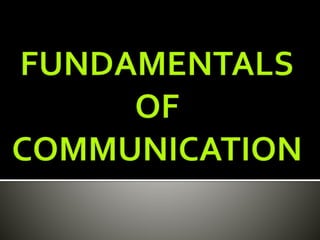Fundamentals of Communication
- 2. A.Definition of Communication B. Nature of Communication C. Process of Communication
- 3. Instructions: 1. Form groups of four. 2. Create a two-minute group presentation that reflects your understanding of what ŌĆ£communicationŌĆØ is about. 3. Be creative. 4. You have 10 minutes to prepare.
- 4. Questions to ponder: 1. As a group, how did you communicate with your group mates? 2. Is effective communication important?Why?Why not?
- 6. INSTRUCTIONS: Each group will choose to write the correct answer on the board. The first to write the correct answer will get a score. No coaching.
- 7. SSSEAEMG
- 8. SSSEAEMG
- 9. MESSAGES
- 10. ITECCMOUNMA
- 11. COMMUNICATE
- 12. PXEEIONRSS
- 13. EXPRESSION
- 14. EYCNOV
- 15. CONVEY
- 16. ESORPN
- 17. PERSON
- 21. Communication is a process of sharing and conveying messages or information from one person to another within and across channels, contexts, media, and cultures (McCornack, 2014).
- 23. Communication occurs between two or more people (the speaker and the receiver).
- 24. Communication can be expressed through written or spoken words, actions (nonverbal), or both spoken words and nonverbal actions at the same time.
- 25. 1. Speaker ŌĆō the source of information or message 2. Message ŌĆō the information, ideas, or thoughts conveyed by the speaker in words or in actions 3. Encoding ŌĆō the process of converting the message into words, actions, or other forms that the speaker understands
- 26. 4. Channel ŌĆō the medium or the means, such as personal or non-personal, verbal or nonverbal, in which the encoded message is conveyed 5. Decoding ŌĆō the process of interpreting the encoded message of the speaker by the receiver 6. Receiver ŌĆō the recipient of the message, or someone who decodes the message
- 27. 7. Feedback ŌĆō the reactions, responses, or information provided by the receiver 8. Context ŌĆō the environment where communication takes place 9. Barrier ŌĆō the factors that affect the flow of communication
- 29. The receiver decodes or interprets the message based on the context. The receiver gets the message. The receiver sends or provides feedback. The speaker generates an idea. The speaker encodes an idea or converts the idea into words or actions. The speaker transmits or sends out a message.
- 30. The speaker generates an idea. The speaker encodes an idea or converts the idea into words or actions. The speaker transmits or sends out a message. The receiver gets the message. The receiver decodes or interprets the message based on the context. The receiver sends or provides feedback.
- 31. Directions: Read information in advance about Models of Communication. Submit your noted salient points about the topic on one whole sheet of paper. Date of submission: Monday, June 18, 2018
- 33. BEAD
- 34. HEAD
- 35. FEED
- 36. FEED
- 37. SAID
- 38. TELL
- 39. AISLE
- 40. SACHET
- 41. REDUCED
- 42. BALLET
- 43. FACADE
- 44. WOMEN
- 45. Peter Piper picked a peck of pickled peppers. A peck of pickled peppers Peter Piper picked. If Peter Piper picked a peck of pickled peppers, WhereŌĆÖs the peck of pickled peppers Peter Piper picked?
- 46. ’ü▒Define communication ’ü▒Elements of communication ’ü▒Communication setting example
- 48. Is there only one way to explain how communication works?
- 51. It is a linear model which consists of three basic elements: the speaker, the subject, and the listener. Whether communication happens or not depends on the listener, who establishes the point of the message. (Oyero, 2010)
- 53. Known as the mother of all communication models, the Shannon- Weaver model (1949) depicts communication as a linear or one- way process consisting of five elements: a source (producer of message); a transmitter (encoder of message into signals); a channel (signals adapted for transmission); a receiver (decoder of message from the signal); and a destination. This model, however, has been criticized for missing one essential element in the communication process: feedback. Without feedback, the speaker will not know whether the receiver understands the message or not.
- 55. Transaction Model is a two-way process with the inclusion of feedback as one element. This model is more interactive. There is a collaborative exchange of messages between communicators with the aim of understanding each other. It also shows that a barrier, such as noise, may interfere with the flow of communication
- 56. 1. Linear communication includes feedback. 2. Shannon and Weaver suggests that information transmission is passed from one person to another. 3. Field of experience refers to a person's background, including his or her culture, life experiences, and heredity. 4. Communication is usually verbal. 5. Communication is an on-going process. 6. Transaction Model is a two-way process with the inclusion of feedback as one element. 7. Shannon-Weaver model is not interactive. 8. Channel is not included in Shannon-Weaver model of communication. 9. Aristotle model is considered as the mother of models of communication. 10. Public speaking is an interactive type of communication.
- 57. 1. Form four groups. 2. Each group will create 2 minute presentation that shows how Shannon-Weaver and Transactional model of communication can be observed. 3. Be creative. 4. You have 15 minutes to prepare.
























































